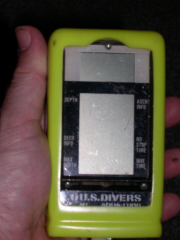Dive computer
|
|
A dive computer or decompression meter is an electronic device used by a scuba diver to measure the dive profile and to display information needed for a safe dive, avoiding decompression sickness.
Early examples of recreational diving computers, from 1979, are the Hans Hass DecoBrain and Orca Edge.
Dive computers address the same problem as decompression tables, but perform a continuous calculation of the partial pressure of gases in the body based on the actual dive profile. As the dive computer automatically measures depth and time, it reduces the need for the diver to carry a separate watch and depth gauge and is able to warn of excessive ascent rates and missed decompression stops. Many dive computers also provide additional information to the diver, for example, the water temperature, or the pressure of the remaining breathing gas in the diving cylinder.
| Contents |
Display information
Dive computers display different dive information to the diver. Most dive computers display the following information on a LCD:
- Current depth.
- Maximum depth reached on this dive.
- No stop time, the time remaining at the current depth without the need for decompression stops.
- Dive time, often measured from the end of the last longer surface interval.
Many dive computers also display additional information:
- Required decompression stop depth and time.
- Water temperature.
- Ascent rates.
- Dive profile (often not displayed during the dive, but transmitted to a personal computer).
Some computers are designed to display information from a diving cylinder pressure sensor, such as:
- Tank pressure .
- Estimated remaining time based on available gas and rate of gas consumption.
Some information is only shown at the surface to avoid an information overload of the diver during the dive:
- "Time to Fly" display showing when the diver can safely board an airplane.
- A log of key information about previous dives.
- Maximum non-decompression bottom times for subsequent dives based on the partial pressure of the gases in the tissue.
Audible information
Many dive computers have warning buzzers that warn the diver of events such as:
- Excessive ascent rates.
- Missed decompression stops.
- Maximum operation depth exceeded.
- Oxygen toxicity limits exceeded.
Operation
Dive computers are battery powered computers within a watertight case. These computers track the dive profile by measuring time and pressure. All dive computers measure the surrounding pressure to estimate the partial pressure of gases in the human tissue. More advanced dive computers also include additional information into the calculations, for example, the water temperature or the diving cylinder pressure.
The computer then uses the profile and a decompression algorithm to estimate the partial pressure of inert gases that has been dissolved in the diver's tissues. Based on these calculations, the computer estimates when a direct ascent is no longer possible, and what decompression stops would be needed.
Examples of decompression algorithms are Buhlmann's algorithm, the Multi-Tissue Model, the Varying Permeability Model, and the Reduced Gradient Bubble Model.
Special purpose dive computers
Some dive computers are able to calculate decompression schedules for breathing gases other than air, such as nitrox, pure oxygen, trimix or heliox. The more basic dive computers only support one or two gas mixes for each dive. Others support many different mixes.
Most dive computers calculate decompression for 'open circuit' SCUBA where the proportions of the breathing gases are constant: these are "constant fraction" dive computers. Other dive computers are designed to model the gases in rebreathers, which maintain constant partial pressures of gases by varying the proportions of gases in the mixture: these are "constant partial pressure" dive computers.
Cautions
The ease of use of dive computers, however, also exposes the diver to other dangers. They allow divers to perform complex dives with little planning. This may lead divers to exceed their competence and experience by relying too much on the computer rather than proper planning, discipline and monitoring.
Many dive computers have menus, various selectable options and various display modes, which are controlled by a small number of buttons on the front of the computer. The diver should become familiar with the control of the computer on a series of shallow and undemanding dives before relying on it for more challenging dives.
For safety reasons it is recommended that a dive plan should be established before the dive and the followed throughout the dive unless the dive is aborted. This dive plan should be within the limits of the decompression tables. This increases the margin of safety, and also provides a backup decompression schedule based on the dive tables in case the computer fails underwater.
Different brands and models of dive computers use different decompression algorithms and safety factors. Some produce conservative decompression schedules and others produce aggressive decompression schedules. The main problem in establishing dive computer algorithms is that the gas absorption and release under pressure in the human body is still not completely understood. Furthermore, the risk of decompression sickness also depends on the physiology, fitness, condition and health of the individual diver.
A diver wishing to reduce the risk of decompression sickness can take a number of precautionary measures such as:
- Use dive computers with a conservative decompression model
- Use safety factors with dive computers (e.g. using a high altitude dive mode for a dive at sea level)
- Add additional deep safety stops during a deep dive
- Make a slow ascent
- Add additional shallow safety stops
- Have a long surface interval between dives
Many computers go into a "lockout" mode for 24 hours if the diver violates the computer's safety limits, to discourage continued diving after an unsafe dive. While in lockout mode, these computers display warning signs telling the diver that the dive computer cannot be used.
External links
- Understanding Buhlmann's algorithm (http://www.lizardland.co.uk/DIYDeco.html)
- RGBM model (http://www.abysmal.com/web/library/articles/abys1.pdf)
- Deco models (http://www.abysmal.com/web/library/articles/deco_model.html)
- Varying Permeability Model (http://www.decompression.org/maiken/VPM/VPM_Program_Site_Map.htm)de:Tauchcomputer

